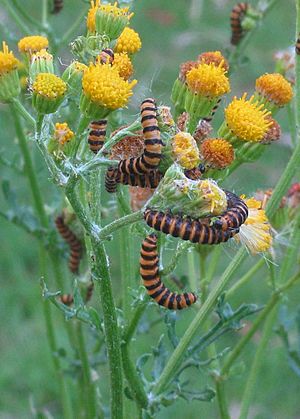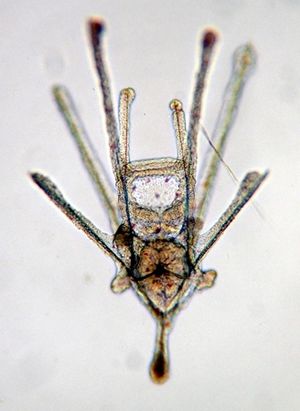Larva facts for kids
Many animals grow through different stages in their lives. A larva (say: LAR-vuh; plural: larvae, say: LAR-vee) is a young form of an animal that hatches from an egg. It is a special stage that looks very different from the grown-up adult animal. As a larva grows, it changes its shape completely. This big change is called metamorphosis. Some animals might even have several different larval stages before they become adults. Good examples of larvae you might know are tadpoles, maggots, and caterpillars.
Many animals that live in the ocean also have a larval stage. These animals often release many eggs and sperm into the water. After the eggs are fertilized, they grow into tiny larvae. These larvae float and swim in the water, growing bigger until they change into their adult form. Most sea invertebrates (animals without backbones) and many fish have these tiny, free-swimming larvae. They live in the plankton, which means they drift with the ocean currents. This allows them to travel long distances.
Contents
Why Animals Have Larvae
Animals have larvae for a few important reasons. One main reason is to help them spread out.
Spreading Out and Finding New Homes
Imagine animals that stay in one place as adults, like barnacles stuck to rocks or mussels on the seafloor. They can't move around much. So, they need a way for their young to find new places to live. Their larvae can swim or drift far away from where their parents live. This helps the species find new homes and avoid overcrowding.
For example, most barnacles go through six different nauplius larval stages. Each time, they molt (shed their outer skin) to grow. After these stages, they change into a cipris larva. This is the stage where they look for a good spot to settle down and become an adult barnacle.
Growing Up from Tiny Eggs
Another reason for larvae is the size of the eggs. Most animals lay many small eggs. The tiny creatures that hatch from these eggs are too small to live like the adults. They need to grow a lot and develop special abilities before they can live an adult life. Larvae are perfect for this. They live a separate life, often eating different foods than the adults, until they are big enough and strong enough to transform.
How Vertebrates Might Have Started
Scientists have a long-standing idea about how vertebrates (animals with backbones, like fish, birds, and humans) might have first appeared. This idea involves the larvae of sea-squirts.
Sea-squirts are simple sea animals that stay in one place as adults. But their larvae are mobile and can swim! These larvae have some features that are similar to early vertebrates. The idea is that over a very long time, some of these larvae might have started to reproduce without ever becoming a sessile adult. This process, where young features are kept into adulthood, is called paedomorphosis.
Studies of animal DNA (their genetic code) show that sea-squirts are actually the closest living relatives to vertebrates. This supports the idea that our ancient ancestors might have looked a lot like a sea-squirt larva!
Images for kids
-
Larva of the Papilio xuthus butterfly.
-
The larvae of the Hercules beetle (Dynastes hercules) are among the largest insect larvae.
See also
 In Spanish: Larva para niños
In Spanish: Larva para niños








